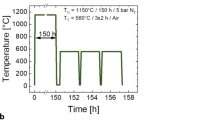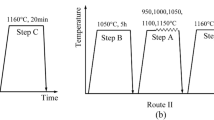Conclusions
-
1.
The number of large carbides (over 9 μ), commensurate with the radius of curvature of the cutting edge, increases with the weight of the ingot, especially in the case of high-tungsten steel R18, which is the result of the solidification conditions.
-
2.
Reducing the tungsten content and adding molybdenum induce refining of the carbides. In deformed tungsten-molybdenum steel R6M5 the number of large carbides is only half that in steel R18. Nevertheless, the number of large carbides remains substantial in steel R6M5 obtained from large ingots (550 kg and larger).
-
3.
The degree of deformation, which has a large effect on the distribution of carbides (carbide heterogeneity), has almost no effect on the size of carbides.
-
4.
For the production of high-speed steels rolled to small sections (diameter up to 20 mm) it is recommended that the ingot weigh 100–150 kg.
Similar content being viewed by others
Literature cited
V A. Sinopal'nikov, "Cutting force in machining with thin shavers", Stanki i Instrument, No. 5, 34 (1962).
Yu. A. Geller and P. A. Andzhyus, "Effect of size of carbide particles in high-speed steel on life of drills", in: Machining and Control and Measuring Instruments [in Russian], No. 11, NIIMASh, Moscow (1971), p. 8.
T. Katsumi, J. Iron Steel Inst. Japan, No. 4, 681 (1966).
A. M. Adaskin et al., "Possibility of improving the properties of W−Mo high-speed steel," Stal', No. 1, 69 (1973).
I. Vero, Acta Tech. Hung., No. 44, 419–435 (1963).
Yu. A. Geller, "Improving the structure of high-speed steel in ingots, rolled sections, and forgings", Stal', No. 9, 831 (1963).
M. Ya. Dzugutov, Plastic Deformation of High-Alloy Steels and Alloys [in Russian], Metallurgiya, Moscow (1971).
Yu. A. Geller et al., "Heat treatment of high-speed steel to improve carbide distribution", Metal. i Term. Obrabotka Metal., No. 9, 18 (1967).
Yu. A. Geller and Yu. E. Sedov, "Effect of small molybdenum additions on properties of tungsten high-speed steels", Stal', No. 4, 358 (1968).
Yu. A. Geller and R. D. Mininzon, "The eutectic of high-speed steel", Stal', No. 6, 549 (1970).
Additional information
Moscow Machine-Tool Institute Planning-Technological Scientific-Research Institute of Machine Construction and Electrotechnology Translated from Metallovedenie i Termicheskaya Obrabotka Metallov, No. 6, pp. 4–9, June, 1975
Rights and permissions
About this article
Cite this article
Sedov, Y.E., Geller, Y.A., Kremnev, L.S. et al. Size of excess carbides in high-speed steels. Met Sci Heat Treat 17, 458–462 (1975). https://doi.org/10.1007/BF00664171
Issue Date:
DOI: https://doi.org/10.1007/BF00664171




